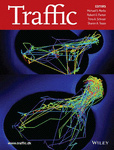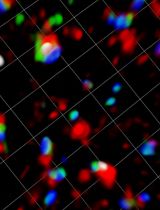- EN - English
- CN - 中文
Real-time Three-dimensional Tracking of Endocytic Vesicles
内囊泡的实时三维追踪
发布: 2020年10月20日第10卷第20期 DOI: 10.21769/BioProtoc.3794 浏览次数: 3711
评审: Guillaume BompardYong TengAnonymous reviewer(s)
Abstract
Endocytic trafficking and recycling are fundamental cellular processes that control essential functions such as signaling protein complexes transport and membrane identity. The small GTPase Rabs are indispensable component of the endosomal recycling machinery. The Rabs bind to effectors to mediate their functions, such as protein sorting and degradation, membrane tethering or lipid modification, and organelle motility. Due to the complex and dynamic nature of endosomal compartments and tracking route, detailed multiparametric analyses of three-dimensional data by quantitative methods are challenging. Here, we describe a detailed time-lapse imaging protocol designed for the quantitative tracking of single endosomal vesicles, using GFP-Rab4-positive recycling endosomes. This method permits automated tracking of single endocytic vesicles in three-dimensional live cell imaging, allowing the study of multiple parameters such as abundance, speed, directionality, and subcellular localization, as well as protein colocalization. This protocol can be broadly used in any kind of cellular models, under various contexts, including growth factors stimulation, gene knockdowns, drug treatments, and is suitable for high throughput screens.
Keywords: Single-vesicle 3D tracking (单囊泡三维追踪)Background
Accumulating evidence emphasizes the importance of coordinated endosomal recycling in such diverse processes as cell migration, adhesion, morphogenesis, proliferation, cytokinesis, as well as learning and memory (Grant and Donaldson, 2009; Parachoniak and Park, 2012; Wandinger-Ness and Zerial, 2014; Zaoui et al., 2019a and 2019b). There are over 70 Rab GTPases in mammals that have distinct localizations and functions in membrane trafficking. Further compounding complexity, while most Rab GTPases are ubiquitous, some display tissue specificity expression (van der Sluijs et al., 1992; McCaffrey et al., 2001; Grant and Donaldson, 2009; Wandinger-Ness and Zerial, 2014). Among them, the small GTPase Rab4, localized in the early endosome, regulates the trafficking along the endocytic route, from early and recycling endosomes, toward the plasma membrane. Rab4 has been involved in the recycling of receptors such as Tfn and receptor tyrosine kinase (RTK), integrins, ubiquitin ligases, as well as other machinery regulators associated with vesicle formation, budding, transport, and fusion (McCaffrey et al., 2001; Grant and Donaldson, 2009; Stenmark, 2009; Parachoniak et al., 2011; Wandinger-Ness and Zerial, 2014; Zaoui et al., 2019a). We recently reported strict requirement of the MT plus-end tracking proteins CLIP-170 for Rab4-mediated Met RTK recycling at the plasma membrane in response to its ligand, hepatocyte growth factor (HGF). The increased localization of Met/Rab4 vesicles towards the MT plus-ends in response to HGF results in enhanced cell protrusion dynamic and cell migration (Zaoui et al., 2019a).
Therefore, by mediating the compartmentalization of the endocytic pathway into early, recycling, late, and lysosomal tracking routes and by regulating the trafficking from vesicle budding to fusion, Rabs stand as essential integrators of cell signaling. Rabs control the localization, the intensity, and the duration of signaling outputs, to allow spatiotemporal regulation of signal transduction (McCaffrey et al., 2001; Stenmark, 2009; Grant and Donaldson, 2009; Parachoniak and Park, 2012; Wandinger-Ness and Zerial, 2014; Zaoui et al., 2019a). Altered endocytosis is observed in many malignancies and can lead to sustained proliferation, survival, invasiveness, and therapeutic resistance (Parachoniak and Park, 2012; Mellman and Yarden, 2013; Zaoui et al., 2019a and 2019b). Our studies aim at understanding endocytic recycling alterations on cell signaling regulating cytoskeletal rearrangement, cell migration, and invasion in oncogenic contexts.
The protocol described herein permits automated tracking of the endocytic vesicle in three-dimensional live-cell imaging, allowing the study and the quantification of multiple parameters under physiological and tumorigenic conditions. Moreover, this methodology can be easily extended to assess the mobility of other Rab family members or any other cell vesicles.
Materials and Reagents
- 35 mm glass bottom cell culture dish (Ibidi GmbH, catalog number: 81158 )
- Microcentrifuge tubes: 1.5 ml (Axygen Corning®, catalog number: MCT-150-C )
- 6-well plate (Nunc®, catalog number: 140675 )
- 100 mm dish (VWR®, catalog number: 172931 )
- SKBr3 breast carcinoma cells (ATCC® HTB-30)
- Hepatocyte growth factor, HGF (Genentech, Inc.)
- DMEM-Dulbecco's Modified Eagle Medium (Gibco®, catalog number: 11966025 )
- Rat tail collagen I (Roche®, catalog number: 11179179001 )
- Foetal Bovine Serum (FBS) (Gibco®, catalog number: 26140079 )
- Green fluorescent protein (GFP)-Rab4 plasmid [provided by Robert Lodge and cloned as described in Zaoui et al. (2019a)]
- Cell line nucleofector Kit V (Lonza®, catalog number: VCA-1003 )
- Phosphate-buffered saline (PBS) (Wisent Inc, catalog number: 311-012-LL )
- Trypsin-EDTA (Gibco®, catalog number: 25200056 )
Equipment
- Cell incubator Steri-Cycle CO2 (Thermo Fisher Scientific®, catalog number: 51030303 )
- Centrifuge (Eppendorf®, catalog number: 5424/5424R )
- Nucleofector 2b device (Lonza®, catalog number: AAB-1001 )
- Motorized Inverted microscope Axiovert 200 M (Carl Zeiss, Inc.)
- Stage top chamber with 5% (v/v) CO2 in air at 37 °C (Climabox, Carl Zeiss, Inc.).
- Objective 100x plan Apochromat NA 1.4 objective
- Hemocytometer (Sigma-Aldrich®, catalog number: Z359629-1EA )
Software
- AxioVision software (Carl Zeiss, Inc.)
- Imaris software (Bitplane Inc.)
- Microsoft Excel®
Procedure
文章信息
版权信息
© 2020 The Authors; exclusive licensee Bio-protocol LLC.
如何引用
Duhamel, S. and Zaoui, K. (2020). Real-time Three-dimensional Tracking of Endocytic Vesicles. Bio-protocol 10(20): e3794. DOI: 10.21769/BioProtoc.3794.
分类
癌症生物学 > 癌症生物化学 > 蛋白质
细胞生物学 > 细胞成像 > 活细胞成像
细胞生物学 > 细胞成像 > 共聚焦显微镜
您对这篇实验方法有问题吗?
在此处发布您的问题,我们将邀请本文作者来回答。同时,我们会将您的问题发布到Bio-protocol Exchange,以便寻求社区成员的帮助。
提问指南
+ 问题描述
写下详细的问题描述,包括所有有助于他人回答您问题的信息(例如实验过程、条件和相关图像等)。
Share
Bluesky
X
Copy link













